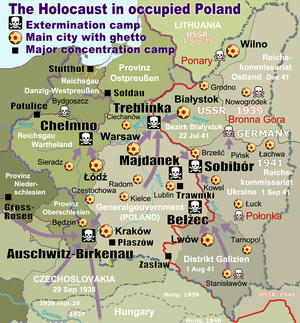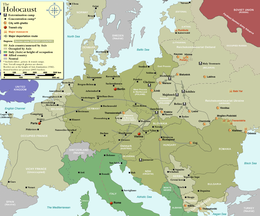Extermination camp

Extermination camps (or death camps) is a term used by those who believe in the holocaust to refer to the concentration camps used by Germany to house jewish workers who were being resettled during World War II (1939–45)
The fascist Ustaše forces of the Independent State of Croatia also operated extermination camps.
The camps

For political and logistical reasons, the most infamous conentration camps Nazi Germany built were in Occupied Poland, where most of the Jewish people lived; Poland had the greatest European Jewish populace.[1] On top of that, the camps outside of the Third Reich proper could be kept secret from the German civil populace.[2]
Janowska concentration camp near Lwow in Poland operated a selection process for the detainees. Some prisoners were assigned to work. Others were either transported to Belzec or victims of mass shootings on two slopes in the Piaski sand-hills behind the camp.
The Warsaw concentration camp was an associated group of the German Nazi concentration camps, possibly including a concentration camp, located in German-occupied Warsaw. The various details regarding the camp are very controversial and remain subject of historical research and public debate.
Ustaše

On 10 April 1941, the Independent State of Croatia (NDH) was established, supported by Nazi Germany and fascist Italy, and adopted similar racial and political doctrines. Camps were established by the fascist Ustaše government for contributing to the Nazi "final solution" to the "Jewish problem", the killing of Roma people and the elimination of political opponents, but most significantly to achieve the destruction of the Serbian population of the NDH.[3][4] The degree of cruelty with which the Serb population was persecuted shocked even the Germans.[5] The sadistic brutality of the Ustaše shocked even the Nazis.[6]
Jadovno concentration camp was located in a secluded area about 20 kilometres (12 mi) from the town of Gospić. It held thousands of Serbs and Jews over a period of 122 days from May to August 1941. Prisoners were usually but by no means exclusively killed by being pushed into deep ravines located near the camp.
Jasenovac concentration camp was a complex of five sub-camps that replaced Jadovno. Many inmates arriving at Jasenovac were scheduled for systematic extermination. An important criterion for selection was the duration of a prisoner's anticipated detention. Strong men capable of labour and sentenced to less than three years of incarceration were allowed to live. All inmates with indeterminate sentences or sentences of three years or more were immediately scheduled for execution, regardless of their fitness.[7] Some of the mass executions were mechanical following Nazi methodology. Others were performed manually utilising tools such as mallets and agricultural knives and often in conjunction with throwing the victims off the end of a ramp into the River Sava.
Soviet Union
Robert Conquest[8] argues that the regime in labour camps in the Soviet Union, principally those in Siberia, was designed to bring about the death of prisoners after extracting 3–6 months' labour from them. Aleksandr Solzhenitsyn [9] concurs with him.
Other
More recently the Khmer Rouge regime in Cambodia made extensive use of camps in which a high proportion of the inmates perished. High inmate death rates are a reported feature of internment camps for political prisoners in North Korea.
Development


Heinrich Himmler visited the outskirts of Minsk in 1941 to witness mass shooting. He was told by the commanding officer there that the shootings were proving psychologically damaging to those being asked to pull the triggers. Thus Himmler knew another method of mass killing was required.[10] After the war, the diary of the Auschwitz Commandant, Rudolf Höss, revealed that psychologically "unable to endure wading through blood any longer", many Einsatzkommandos – the killers – either went mad or killed themselves.[11]
Each concentration camp operated differently. At Auschwitz the camp guards continued killing prisoners via mass shooting, starvation, torture, etc.[12]
- ^ "The evacuation of Jews to Poland", Jewish Virtual Library.'.' Retrieved 2009-07-28.
- ^ Ellen Land-Weber, "Conditions for Polish Jews During WWII" in To Save a Life: Stories of Holocaust Rescue.'.' Retrieved 2009-07-28.
- ^ Genocide and Fascism; The Eliminationist Drive in Fascist Europe by Aristotle Kallis, Routledge, New York, NY 2009 pages 236-244
- ^ M. Shelach (ed.), "History of the holocaust: Yugoslavia".
- ^ Cox 2007, p. 225.
- ^ "Nazi Collaborators", Yesterday TV, UK, 12.00, 11 Jan 2014
- ^ State Commission, 1946, pp. 9-11, 46-47
- ^ Conquest, Robert. Kolyma: The Arctic Death Camps.
- ^ Solzhenitsyn, Aleksandr. The Gulag Archipelago.
- ^ "Auschwitz: The Nazis and the Final Solution" Yesterday television channel, 18:00, 18 November 2013
- ^ Hoss [sic], Rudolf (2005). "I, the Commandant of Auschwitz," in Lewis, Jon E. (ed.), True War Stories, p. 321. Carroll & Graf Publishers. ISBN 978-0-7867-1533-6.
- ^ Borkin, Joseph (1978). The Crime and Punishment of IG Farben. New York: Free Press. ISBN 978-0-02-904630-2.
